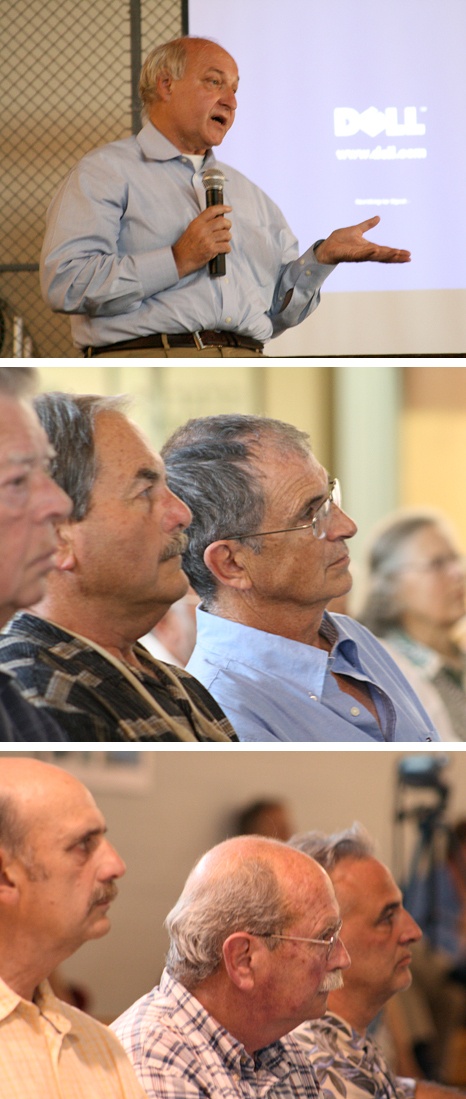An estimated 300 islanders crowded into Friday Harbor High School’s Hall Gym on Tuesday to hear a panel of well-credentialed experts take issue with the state’s best available science and pending changes to the county’s Critical Areas Ordinance.
The heat did little to dampen interest in the forum, sponsored by the Common Sense Alliance. The public meeting on the state-required CAO update featured four panelists who called on islanders to take a critical look at the “best available science” developed by various state agencies and cautioned against accepting it on face value.
If uncontested, the panelists warned, the science championed by the state — the driving force behind the proposed update — could result in unnecessary restrictions on the use of private property.
According to Dennis Reynolds, an attorney with 37 years of experience in public and private land use, San Juan County will be in a battle it can’t win if it tries to beef up regulations of its saltwater shorelines under the Critical Areas Ordinance, a section of the state Growth Management Act. The county should instead concentrate on its critical “upland” areas and take up its shoreline rules as part of the upcoming revision of its shoreline master program, which is governed by the state Shoreline Management Act and is due by 2012.
Furthermore, Reynolds, who at one time was counsel for the state Fish and Wildlife and Ecology departments, believes those agencies have reached too far in determining what is “critical” and in need of broader protections. He noted among the goals of the GMA is striking a “balance” between regulatory measures and the resulting impacts on communities, and cautioned the crowd to wary of “generic, one-size-fits-all buffers.”
“There are 13 goals in the Growth Management Act, and science is not one of them,” he said. “I do believe in protecting critical areas, but not everything is critical.”
Cities, towns and counties, like San Juan, whose long-range planning is dictated by the state Growth Management Act, are required to periodically revise their local rules governing critical areas. Those areas include wetlands, critical aquifer recharge areas, areas prone to frequent flooding, steep and unstable slopes, and fish and wildlife habitat. San Juan County received an extension for revising its CAO, as did many other counties, after missing a 2005 deadline.
Some say changes need to go farther to protect the county’s shorelines, and they propose a 150-foot building setback from the shoreline and 100-foot setback from wetlands. Others say current setbacks are sufficient, and that the county should be focusing on upland areas.
Trent England, director of the Citizenship and Governance Center at Evergreen Freedom Foundation, said the complexity of state law and technical nature of issues such as the revision of a critical areas ordinance can be intimidating, much like having to delve into an owner’s manual to program a VCR and get rid of that flashing “12:00.” However, England said there are resources and advocacy groups that specialize in protecting property rights. He encouraged islanders to stay involved and to get educated about the CAO process and their rights as property owners.
Similarly, William Maurer, director of the Institute for Justice, said the Washington state Constitution is even more protective of private property rights than the federal constitution, and that state law doesn’t allow government to “take” or “damage” private property without just cause or compensation.
“Expressed in the words of the Washington Constitution are restrictions on government’s ability to take actions which damage property,” Maurer said.
Dr. Kenn Brooks, a marine ecologist and physicist, is the owner of Aquatic Environmental Sciences and spoke on the topic of “The What, Why and How of Protecting Shorelines and Critical Areas.” He said that the size of buffers and setbacks that Ecology and Fish & Wildlife are requiring counties to include in CAO revisions have not undergone a rigorous “peer review” and, as a result, lack credibility.
Brooks said that much of the best available science championed by those departments has been extrapolated from other studies with little relevance on buffers, setbacks or wetlands in rural areas like the San Juans. He said islanders should encourage their elected officials to challenge the origins and scientific underpinnings of the protections championed by the state.
“San Juan County should demand that all the best available science accepted by the county has to be peer-reviewed,” Brooks said. “They should not allow themselves to be bullied by state agencies.”




